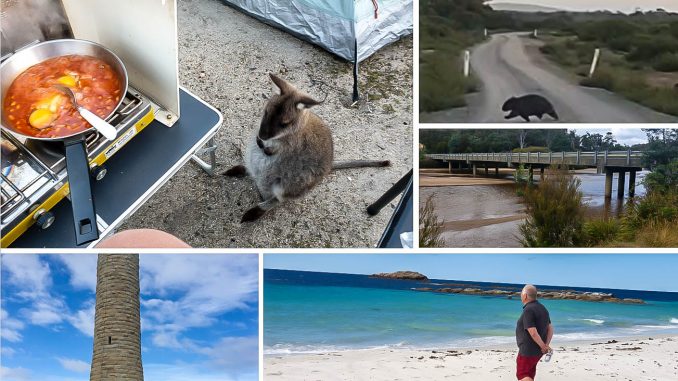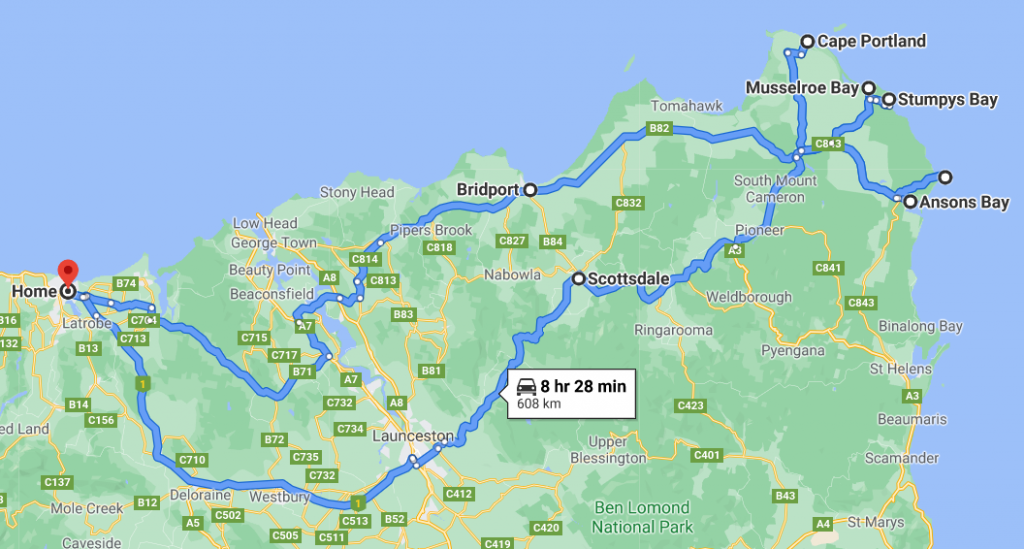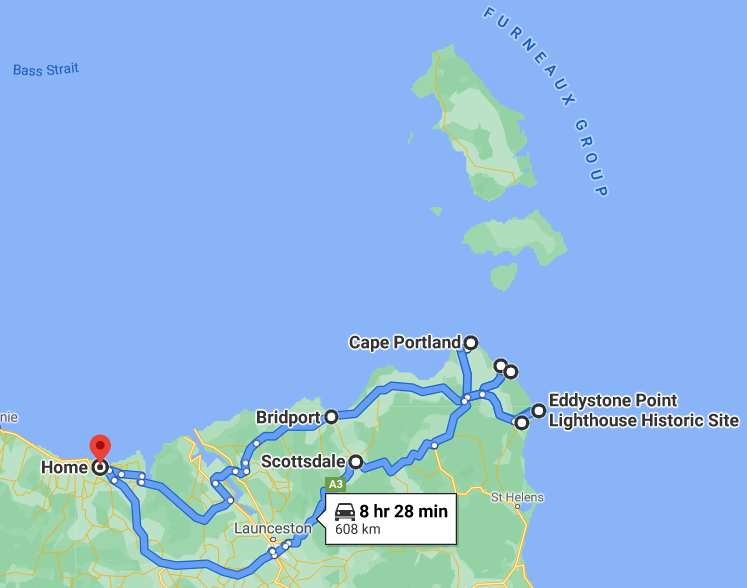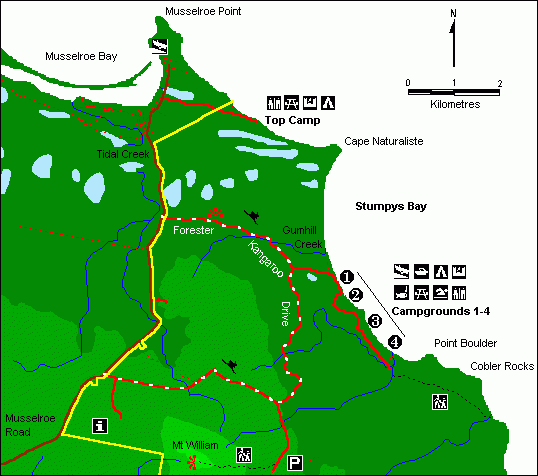
Last week we went on a three-day, two night camping trip, to the far north-eastern tip of Tasmania. There we discovered the wonderful hidden paradise of Mt William National Park.
On the way, we crossed the Tamar River via the Batman’s Bridge…
I’ve always loved this bridge. It looks so unusual out there in a very underpopulated area.
We used to live within ten minutes of this bridge… you can read it’s interesting history here, in one of my previous posts:
Then we tracked up to Bridport on the north coast, and finally over to Stumpys’ Bay which is in the Mt William National Park, our destination.
The wonders of Mt William National Park
The hidden paradise of Mt William National Park is one of the least visited national parks in Tasmania, but not because it isn’t completely wonderful. It’s just that it’s so out of the way.
Driving into the park we could clearly see the group of islands that make up the Furneaux Group. I mean, they were just there! They include Flinder’s Island, Cape Barron Island and a few others.
It was amazing to us that we could see them so clearly.
Four Camp Spot Choices
We had a choice of four camping spots within the national park.
We chose #3. #1 was too exposed; #2 was just for tents but didn’t appeal to us; #4 was beside a lagoon that may have contained mosquitoes… but #3 was just right!
There was plenty of foliage and trees around giving a certain amount of protection from the wind.
But, the weather was calm and warm. This area of Tasmania is renowned for extreme wind conditions. We knew the prevailing wind would need to find it’s way through the scrub at the back of us and, there were no overhanging trees.
We had the tent set up in record time and enjoyed a little lunch on the picnic table, accompanied by our new little friend…
The lure of a hidden paradise!
As soon as our stomachs were satisfied, we walked a whole 2 minutes to the beach!
Oh, it was a site for sore eyes! It really was that colour. The white sands stretched both up and down the beach from that point. Now we knew why it’s referred to as a hidden paradise!
We spent many a time, paddling up and down that wonderful beach.
Swimming was not an issue. There were warnings around to say that a very strong rip ran the length of the beach. Being an isolated area, we were not about to test our luck!
Later in the day as the skies clouded over, it was fascinating to watch the waves roll in from two different directions.
Notice the change in the colour of the water.
Sunset and Sunrise – both glorious!
Walking back home after one of our leisurely beach walks, we looked behind us and saw the sky was on fire. So beautiful.
Next morning we were out of bed nice and early to see the sun rise. It was worth it!
The dreaded wind had picked up during the night and with the way our tent was flapping and rising, we didn’t get much sleep. The end of it kept flapping against my head, so I hid in the hood of the sleeping bag.
At the beginning of the night we could hear the surf loudly, but as the night progressed, the sound of the wind became so strong we could no longer hear the surf.
It turned out that the strength of the wind was just on gale force… and here were we in a tent!
Paradise of hidden delights…’Our little baby’
Now to tell you about our new little friend…
While ever we were at the campsite, our darling little friend spent all of his time with us. It didn’t seem to matter how much noise we made. As I sat and cooked up some eggs and beans for breakfast, he took great interest in the proceedings. I was able to run my hand lightly over his head.
The animals in the park were all wild animals, but he was obviously very used to the campers, although you’re not allowed to feed them. Of-course I wanted to pick him up and take him home with me.
Many other larger Bennett’s Wallabies were around the campsite. Hardly was there a time when you walked outside the tent that there weren’t five or six of them right there.
But none of the others were as friendly and docile as ‘our little baby’!
Exploring the north eastern tip
The wild wind continued throughout our first full day. But it didn’t bother us as we were travelling around seeing the sites.
Very windy conditions soon had all the 56 wind turbines turning at the Musselroe Wind Farm, the largest farm in Tasmania. They are 80 metres high with blades 44 meters long!
When we first saw them from the national park, they were all still.
They are really a blight on the landscape, but never-the-less, it was interesting driving through. The road took us right beside many of them.
After driving through the wind farm, we came to a stop at Cape Portland. Down some steps and onto a magical hidden paradise of the Cape Portland beach. Not a soul in sight!
I believe the tip you can see is the furthest point of north-eastern Tasmania. Unfortunately we couldn’t get right there which was a shame. I guess we could have walked there maybe, but we had other plans for the day.
There are no houses in this part of Tasmania… right up there at the tip. Only the wind farm and an information centre.
On our way back towards home, we took a turn to the right and drove out to Petal Point. We just wondered what we would see.
As it turned out, there was a camp ground but I couldn’t imagine camping in it. The wind was howling and the surf had really picked up.
No beach that we could see… just endless rocks along the shoreline. We were now looking along the north coast of Tasmania.
The southern end of Mt Williams National Park
We decided to discover what was down at the far southern part of the Mt Williams National Park. So we drove back to Gladstone and then on down to Anson’s Bay. Not a great deal to see there, so we took a road leading to Eddystone Point.
Once again, the same incredible water.
Lording over Eddystone Point, just north of Ansons Bay within Mt William National Park, the 35m-high granite tower of Eddystone Point Lighthouse has warned ships off this rocky shoreline since 1889.
Lonely Planet
Home to devastation!
On returning to our camp, we found that the front half of the tent was in a heap, and the inside furniture was all over the place.
Here we were on our second camping experience… we froze at Waratah and now blown to bits at Mt William!
But do you know what’s amazing? Selwyn has not been put off one bit… he just wants more!
Anyway, ferociously the wind continued until about 7.30 – 8.00pm that night and then, just like that… it was gone!
We went to sleep that night to the sound of the surf pounding loudly, but no wind. The next morning it was still calm and the ocean has quietened right down.
Home for the wild
They say you should never stay in the national park without taking a dusk-time tour to see the wildlife.
I guess we took about an hour driving ever so slowly, seeing the Forester Kangaroo (Eastern Grey), Bennett’s Wallabies and wombats.
Of-course I loved every minute of it. So wonderful. They were jumping or running everywhere.
The next day when we were leaving the park we saw a large eagle just in the trees above us. It was being chased off by the crows. This was another sight we were told to look out for.
Turquoise water says ‘Come on in’!
Time to leave Mt Williams National Park… so sad to go!
On the way, making our way towards home, we stopped off to see the Little Blue Lake. We’d been there a couple of times before, but we never tire of seeing that water!
The water really is the colour you are seeing.
It was created through tin mining. After they had finished with the mining, they replaced much of the material that had been previously removed. The vivid turquoise colour is caused by the white clay reflecting the clear blue of the sky.
I guess it would be interesting to see it on a dull day…
It is not recommended for swimming as it’s very acidic and high in aluminium. But having said that, I’ve seen people swimming there. No thanks!
Are there any gem stones for me?
To complete our 3 day, 2 night camping trip, we decided to try our hand fossicking for gems. This river contains many different lovely gemstones, including sapphires… blue, pink/red and green.
I would have been more than delighted to have found one, but it wasn’t to be. Mind you, it was our first time ever so I’m not sure we really knew what we were doing.
On the way back out from the river we met a couple who did know and they gave us some pointers. Enough to create interest in trying again… another time.
So our little hidden paradise camping tour had now come to an end. All we had to do is drive back to Devonport. What a wonderful experience to be able to enjoy all that nature and forget everything going on in the world for a time! Now back to more research and following the happenings in the world around us.
![]()






















Leave a Reply